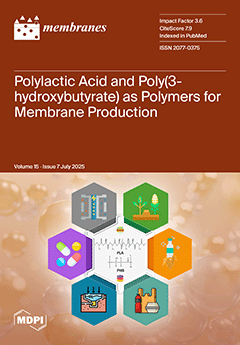Membrane fouling poses a significant challenge in the widespread adoption and cost-effective operation of membrane technology. Among different strategies to mitigate fouling, dynamic membrane (DM) technology has emerged as a promising one for effective control and mitigation of membrane fouling. Silicon carbide (SiC)
[...] Read more.
Membrane fouling poses a significant challenge in the widespread adoption and cost-effective operation of membrane technology. Among different strategies to mitigate fouling, dynamic membrane (DM) technology has emerged as a promising one for effective control and mitigation of membrane fouling. Silicon carbide (SiC) membranes have attracted considerable attention as membrane materials due to their remarkable advantages, yet membrane fouling is still inevitable in challenging separation tasks, such as oil-in-water (O/W) emulsion separation, and thus effective mitigation of membrane fouling is essential to maximize their economic viability. This study investigates the use of pre-deposited oxide DMs to mitigate the fouling of SiC membranes during the separation of O/W emulsions. Among five screened oxides (Fe
2O
3, SiO
2, TiO
2, ZrO
2, Al
2O
3), SiO
2 emerged as the most effective DM material due to its favorable combination of particle size, negative surface charge, hydrophilicity, and underwater oleophobicity, leading to minimized oil droplet adhesion via electrostatic repulsion to DM surfaces and enhanced antifouling performance. Parameter optimization in dead-end mode revealed a DM deposition amount of 300 g/m
2, a transmembrane pressure (
TMP) of 0.25 bar, and a backwashing pressure of 2 bar as ideal conditions, achieving stable oil rejection (~93%) and high pure water flux recovery ratios (
FRR, >90%). Cross-flow filtration outperformed dead-end mode, maintaining normalized permeate fluxes of ~0.4–0.5 (cf. ~0.2 in dead-end) and slower
FRR decline, attributed to reduced concentration polarization and enhanced DM stability under tangential flow. Optimal cross-flow conditions included a DM preparation time of 20 min, a
TMP of 0.25 bar, and a flow velocity of 0.34 m/s. The results establish SiO
2-based DMs as a cost-effective strategy to enhance SiC membrane longevity and efficiency in O/W emulsion separation.
Full article






